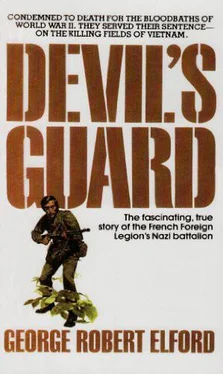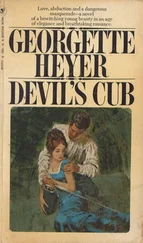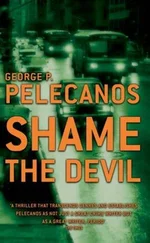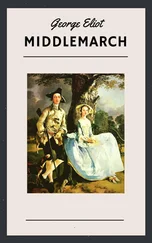Back at the hole Sergeant Krebitz installed the second flamethrower that was soon followed by a third one. Suddenly a pair of hands popped to the surface, eighty yards downstream from where we stood. They submerged instantly.
“There they go!” a trooper yelled and cut loose with his submachine gun.
The hunt was on! More hands appeared, singly or in clusters of threes and fours—a couple of heads broke the surface, but stayed in sight for only a fraction of a second. As the guns sprayed the water, Schulze yelled, “Use hand grenades, men! The grenades will bring them up or send them down for good.”
Many of the swimmers escaped the bullets but none survived the subsurface explosions. The grenades were deadly. As the river erupted in a dozen muddy funnels of water the swimmers popped to the surface, many of them dead. Others who suffered internal injuries from the concussions thrashed aimlessly until the machine guns silenced them forever. Twenty yards from where we stood a pair of hands rose from the subsiding waves of a blast; the fingers moved, twisting and grasping like a disembodied pair of ghastly limbs trying to signal. The nearest trooper pivoted his light machine gun toward the easy target. A hail of slugs hit the hands and tore them away at the wrist. The bleeding stumps shook crazily, then sank out of sight. A wounded guerrilla emerged and stood waist-deep in the water with blood oozing from his ears and nostrils; raising his arms he staggered toward the bank; he fell, rose again, crying: “Mercy… mercy.”
An instant later the slugs knocked him back into the water.
One after another the guerrillas surfaced—dazed, shocked, exhausted, unable to swim the corridor of death. A few of them tried to crawl ashore, others just stood in the shallow water dumbfounded or blinded, until the bullets spun them back into their murky graves.
Suddenly there were no more guerrillas in sight. The river flowed peacefully as if nothing had happened.
When the smoke cleared, Sergeant Krebitz surveyed the tunnels, altogether two hundred yards long. It was a well-built complex with several large chambers for stores and sleeping quarters. Krebitz counted three hundred bunks.
Three of the chambers were loaded to capacity with weapons and ammunition. Sergeant Krebitz selected what we could use, then the tunnels were blown up . with delayed-action charges. The explosion tore a thirty-foot-wide and twenty-foot-deep trench across the village; the ensuing air pressure flattened every hut within a radius of five hundred steps in either direction.
None of the villagers had been hurt, except by the sad fact that they had no village to return to, but, alas, c’est la guerre! If one plays with fire, one can burn oneself.
We buried Karl Pfirstenhammer on a hill and placed a heavy boulder over his improvised grave. I sat there for a long time with Noy, telling her of my meeting with Karl on the Danube in 1945; the wine we drank, the fried fish we ate, his clay pipe… his little sister Erika, who was now a young lady, studying to become a doctor. In my kit I had Karl’s wallet with her picture, and it was my gloomy task to write her a letter—the last letter she would receive from Indochina.
Sergeant Krebitz erected a small wooden cross. On it we nailed Karl’s French beret and his Wehrmacht belt inscribed: “Gott Mit Uns”—“God Be with Us”—that he always wore.
We stood in attention, then sang in a low tune: Heil dir im Siegeskrant, Heil dir im Siegeskranz.…
A last salute—then tears were wiped away and guns flung over the shoulders. Forward!
17. THE RED HIGHWAY (OPERATION “DELUGE”)
The battalion was camped for the fifth day, but the downpour did not seem to lessen. It was raining without a break; the hours of daylight shortened and deep in the jungle between the thickly forested hills the hours of darkness stretched to almost eleven hours. A wicked wind blew from the southeast, tearing at our flimsy lean-to shelters and driving the heavy drops through our fatigues and underwear.
Cooking was out of question and our tobacco turned into a soggy mess that could not be lit. Since the rain started our diet had consisted of dried fish, biscuits, and vitamin pills. The only fire which we were able to light was burning inside a shallow crevice, barely large enough to accommodate the girls. There we prepared boiled sweet potatoes, rice with curried fish, and occasionally a cup of tea for the girls and for Xuey, who was down with fever and abdominal pain.
Sergeant Zeisl suspected appendicitis, a condition which in the circumstances was a death sentence. Our faithful little Indochinese companion knew it too and he accepted the inevitable with a faint ironic smile saying: “We all have to go one day. Just let me go without much pain.”
I sat beside him for a long time under the tarpaulin sheet which the men had rigged up between the trees to make a primitive tent.
“You have reached your objective,” Xuey said, giving my hand a feeble squeeze, “but you will have to be very careful from now on. A hundred times more careful than ever before. Those down there are professionals.”
He turned his face slightly toward the steaming valley. “They overlook nothing.”
Even now he only thought of our welfare. Then he asked for some sleeping pills and Zeisl obliged.
The densely wooded plateau where we had established ourselves, for better or worse, was the only place where the streams, now swollen to rivers, wouldn’t flood us. Throughout the night we heard the crashings of uprooted trees and the distant thud of tumbling rocks and earth. During the day, the entire world seemed to be moving downward, along the slopes, into the valley.
Barely two miles away, in a narrow valley, was an important terrorist supply base, “a king’s ransom” as Schulze put it. A twelve-foot-wide jungle road ran through the enemy camp and into it entered a network of smaller paths. We had arrived at the long-sought “Red Highway,” the main terrorist supply route between China and the southern provinces. No troops of the Foreign Legion had ever before come closer to it than a hundred kilometers. Its existence had been suspected but never proven. Only airplanes were able to penetrate so far into the Communist rear; they had done so on many occasions but had observed nothing but unbroken jungles. Like all the important Viet Minh establishments in the hills, the Red Highway was a masterpiece of camouflage. It had been cut through the jungle without allowing as much as ten yards of it to be exposed to the skies. At a few less densely wooded sections, hundreds of trees had been roped together and drawn closer to one another with the aid of pulley-like contraptions. Then they had been fastened in such a way that their crowns intertwined over the road. In the open ravines networks of strong wire had been stretched between the slopes to support creepers, which had soon blotted out the road beneath.
The jungle road included permanent bridges, twelve to fifteen feet wide, most of them constructed a few inches underwater to fool aerial observation. Difficult or swampy sections of the road had been “paved” either with stones or with logs leveled with gravel. Along the Red Highway were checkpoints where guerrilla MP’s controlled transport or troop movements. Rest-houses and service stations where carts and bicycles could be repaired also were located on that incredible network of trails. Its very existence was ridiculed by some leading French statesmen. It was simply too incredible to believe. Yet it was there! Here the enemy was no longer taking chances. While trying to approach the camp to have a better look, Xuey and Sergeant Krebitz had had to stop short of concealed machine gun positions at eight different points. The emplacements were not easily observable, though they were not hastily dug foxholes but what one may rightly call permanent fortifications. Small blockhouses, constructed of heavy logs, covered with earth in which shrubs had then been planted, commanded all the approaches to the Viet Minh base. Along the relatively short section of the jungle road which Xuey had been able to investigate, he spotted two Viet Minh observation platforms. Rigged up high on the hilltop trees, the platforms offered a perfect view of the neighborhood. The guerrilla lookouts could spot not only airplanes but also any overland intruders who imprudently proceeded across the nearby ridges.
Читать дальше












